Research on Indoor Thermal Comfort and Age of Air in Qilou Street Shop under Mechanical Ventilation Scheme: A Case Study of Nanning Traditional Block in Southern China
Abstract
1. Introduction
- (1)
- The existing research mostly focuses on ordinary shopping malls and large commercial complexes by measuring and qualitatively assessing their thermal environments. For traditional shopping streets in particular climates (such as humid and hot ones), the indoor thermal environment is greatly affected by the outdoor block layout and diverse human activities. Hence, the existing research findings are not sufficiently applicable to qilou shopping streets in humid and hot climates.
- (2)
- The two widely applied thermal comfort models, the PMV model proposed by Fanger [26] and the adaptive model presented by de Dear [27], do not take indoor air cleanliness into account. The IAQ, however, is also a research topic of significant and growing interest [28]. In order to improve the IAQ of school classrooms in the subtropical region, Liu et al. [29] analyzed the area ratio of AoA in the classroom plane to determine the optimal window orientation. For providing useful information for comprehending the situation of air quality in sensitive indoor and outdoor areas, Lucialli et al. [30] performed a test to investigate the indoor and outdoor concentrations of benzene, toluene, ethylbenzene, and xylene in eight schools. The results are helpful to enhance environmental quality in school construction renovation programs. Since classrooms and shops have similarities in air quality requirements and crowd density, the study of IAQ in classrooms has enlightened the IAQ study in shops. For the purpose of investigating the main influencing factors of air quality in commercial settings, Zhang et al. [31] continuously monitored IAQ in two large-scale comprehensive commercial places in Beijing and found that IAQ in functional areas of the shopping mall was related to human activities, ventilation, air freshness, and so on. The outbreak of COVID-19, furthermore, has increased the awareness of the importance of IAQ. Maintaining air freshness through healthy ventilation is critical for improving the IAQ of shops.
2. Micro-Climate Environment in Qilou Street Block
3. Indoor Thermal Comfort and AoA
3.1. PMV and Predicted Percentage of Dissatisfied (PPD)
3.2. AoA
4. Measurement and Simulation
4.1. Measurement
4.2. Simulation
5. Optimization and Discussion
6. Conclusions
- (1)
- An investigation shows that the human thermal comfort sensation in shops is affected by indoor environmental factors, such as air temperature, velocity, and humidity. This finding is consistent with the PMV-PPD thermal comfort theory. In addition, the quality of the indoor thermal environment is closely related to shopping behavior, and a comfortable and healthy environment has a positive effect on commercial consumption.
- (2)
- The qilou street shop is enclosed on three sides, and the entrance opens towards the colonnade. The rear space of the shop has weak air movement owing to the windowless rear wall, and cool air concentrates there, resulting in low temperature. The front space of the shop has inadequate ventilation and relatively high air temperature, resulting in a low thermal comfort level and directly affecting the consumption behavior. Hence, under natural ventilation, the airflow field in the colonnade walkway space is conducive to improving the indoor thermal environment inside the shop.
- (3)
- A comparative analysis of three ventilation schemes (upper-inlet–bottom-outlet, upper-inlet–upper-outlet, and side-inlet–side outlet) for the qilou street shop showed that the upper-inlet–upper-outlet scheme is more beneficial to creating a comfortable thermal environment and to improving the air freshness level in the shop along qilou streets. Additionally, the agreement between this result and the finding derived from other literatures [43,44] suggests the accuracy of the analysis adopted in this study and its further application.
Author Contributions
Funding
Institutional Review Board Statement
Informed Consent Statement
Data Availability Statement
Conflicts of Interest
References
- Ma, X.; Fukuda, H.; Zhou, D.; Gao, W.; Wang, M. The study on outdoor pedestrian thermal comfort in blocks: A case study of the Dao He Old Block in hot-summer and cold-winter area of southern China. Sol. Energy 2019, 179, 210–225. [Google Scholar] [CrossRef]
- Qin, C.; Lu, W. Effects of ceiling exhaust location on thermal comfort and age of air in room under impinging jet supply scheme. J. Build. Eng. 2021, 35, 101966. [Google Scholar] [CrossRef]
- Kelly, F.J.; Fussell, J.C. Improving indoor air quality, health and performance within environments where people live, travel, learn and work. Atmos. Environ. 2019, 200, 90–109. [Google Scholar] [CrossRef]
- Wyon, D.P. The effects of indoor air quality on performance and productivity. Indoor Air 2004, 14, 92–101. [Google Scholar] [CrossRef] [PubMed]
- Huang, X.; Li, C.; Zhuang, Z. Analysis of height-to-width ratio of commercial streets with arcades based on sunshine hours and street orientation. Appl. Sci. 2021, 11, 1706. [Google Scholar] [CrossRef]
- Yahia, M.; Johansson, E. Influence of urban planning regulations on the microclimate in a hot dry climate: The example of Damascus, Syria. J. Hous. Built Environ. 2013, 28, 51–65. [Google Scholar] [CrossRef]
- Krüger, E.; Minella, F.; Rasia, F. Impact of urban geometry on outdoor thermal comfort and air quality from field measurements in Curitiba. Build. Environ. 2011, 46, 621–634. [Google Scholar] [CrossRef]
- Qi, J.; Adam, N.; Sahari, B. Thermal comfort assessment and potential for energy efficiency enhancement in modern tropical buildings: A review. J. Energy Build. 2014, 68, 547–557. [Google Scholar]
- Ozel, M. Effect of indoor design temperature on the heating and cooling transmission loads. J. Build. Eng. 2016, 7, 46–52. [Google Scholar] [CrossRef]
- Wang, Y.; Chen, Y.; Xiao, X.; Kan, W.; Luo, X. Investigation and analysis on energy consumption of market buildings in Guangzhou. Build. Sci. 2012, 28, 67–71. [Google Scholar]
- Hwang, Y.; Lum, Q.; Chan, Y. Micro-scale thermal performance of tropical urban parks in Singapore. Build. Environ. 2015, 94, 467–476. [Google Scholar] [CrossRef]
- Gao, H. Arcade and Arcade Street, Guangzhou. Master’s Thesis, Xi’an University of Architecture and Technology, Xi’an, China, 2003. [Google Scholar]
- Jung, J. Spatial distribution characteristics and protective measures of Guangzhou Qilou Street. Urban Plan. 1999, 11, 18–25. [Google Scholar]
- Chen, J.; Liu, J. Arcade street in Haikou under the change of commercial pattern. Build. Sci. 2011, 10, 13–19. [Google Scholar]
- Djongyang, N.; Tchinda, R.; Njomo, D. Thermal comfort: A review paper. Renew. Sustain. Energy Rev. 2010, 14, 2626–2640. [Google Scholar] [CrossRef]
- Yan, H.Y.; Mao, Y.; Yang, L. Thermal adaptive models in the residential buildings in different climate zones of Eastern China. Energy Build. 2017, 141, 28–38. [Google Scholar] [CrossRef]
- Zaki, S.A.; Damiati, S.A. Adaptive thermal comfort in university classrooms in Malaysia and Japan. Build. Environ. 2017, 122, 294–306. [Google Scholar] [CrossRef]
- Ruiz, M.A.; Correa, E.N. Adaptive model for outdoor thermal comfort assessment in an Oasis city of arid climate. Build. Environ. 2015, 85, 40–51. [Google Scholar] [CrossRef]
- Jin, H.; Liu, S.; Kang, J. The thermal comfort of urban pedestrian street in the severe cold area of northeast China. Energy Procedia 2017, 134, 741–748. [Google Scholar] [CrossRef]
- Li, L.; Yan, J.; Zhou, X.; Feng, J. Study on indoor thermal comfort of shopping malls in hot summer and warm winter zone. Heat. Vent. Air Cond. 2015, 6, 76–81. [Google Scholar]
- Chen, C. Study on Thermal Comfort in Winter in Functional Area of Comprehensive Shopping Mall in Hot Summer and Warm Winter Zone. Master’s Thesis, South China University of Technology, Guangzhou, China, 2016. [Google Scholar]
- Dang, R.; Yan, Z.; Liu, K.; Shan, C.; Liu, G. Study on indoor thermal comfort evaluation model of large-scale commercial complex in cold area in winter. Build. Sci. 2017, 33, 16–21. [Google Scholar]
- Zhang, L.L. Numerical simulation and analysis of air distribution in a hotel lobby. Clean Air Cond. Technol. 2020, 1, 21–26. [Google Scholar]
- Huang, Z.; Shen, J. Indoor air quality research for large shopping malls in Ma’anshan. Heat. Vent. Air Cond. 2006, 36, 101–104. [Google Scholar]
- Henderson, H.I.; Rengarajan, K.; Shirley, D.B. The impact of comfort control on air conditioner energy use in humid climate. ASHRAE Trans. 1992, 98, 104–113. [Google Scholar]
- Fanger, P.O. Thermal Comfort; Danish Technical Press: Copenhagen, Denmark, 1970. [Google Scholar]
- de Dear, R.J.; Brager, G.S. Thermal comfort in naturally ventilated buildings revisions to ASHRAE Standard 55. Energy Build. 2002, 34, 549–562. [Google Scholar] [CrossRef]
- Staveckis, A.; Borodinecs, A. Impact of impinging jet ventilation on thermal comfort and indoor air quality in office buildings. Energy Build. 2021, 235, 110738. [Google Scholar] [CrossRef]
- Liu, X.; Yang, L.; Qian, F. Study on ventilation conditions for different types of teaching buildings. Build. Sci. 2019, 35, 102–109. [Google Scholar]
- Lucialli, P.; Marinello, S.; Pollini, E.; Scaringi, M.; Sajani, S.Z.; Marchesi, S.; Cori, L. Indoor and outdoor concentrations of benzene, toluene, ethylbenzene and xylene in some Italian schools evaluation of areas with different air pollution. Atmos. Pollut. Res. 2020, 11, 1998–2010. [Google Scholar] [CrossRef]
- Zhang, Y.; Zhao, R.; Jia, Y.; Shen, F. Air quality pollution levels in two large comprehensive commercial sites in Beijing. Occup. Health 2014, 30, 2623–2625. [Google Scholar]
- Lin, Z.; Chow, T.T.; Tsang, C.F.; Fong, K.F.; Chan, L.S. Stratum ventilation—A potential solution to elevated indoor temperatures. Build. Environ. 2009, 44, 2256–2269. [Google Scholar] [CrossRef]
- China Meteorological Administration, Department of Building Technology Science, Tsinghua University. Special Meteorological Data Set for Thermal Environment Analysis of Buildings in China; China Architecture & Building Press: Beijing, China, 2005. [Google Scholar]
- Huang, Z.; Li, L.; Zhao, L.; Zhao, X. Quantitively analysis for impact of first floor overhead on natural ventilation under different building densities and plot ratios. HVAC 2016, 49, 124–127. [Google Scholar]
- ISO 7730: 2005 Ergonomics of the Thermal Environment—Analytical Determination and Interpretation of Thermal Comfort Using Calculation of the PMV and PPD Indices and Local Thermal Comfort Criteria; International Organization for Standardization: Geneva, Switzerland, 2005.
- ASHRAE. ANSI/ASHRAE Standard 55–2010. Thermal Environmental Conditions for Human Occupancy; American Society of Heating, Refrigerating and Air-Conditioning Engineers, Inc.: Atlanta, GA, USA, 2010. [Google Scholar]
- Sandberg, M.; Sjoberg, M. The use of moments for assessing air quality in ventilated rooms. Build. Environ. 1983, 18, 181–197. [Google Scholar] [CrossRef]
- Li, D.; Li, X.; Yang, X.; Yang, J. Total air age in the room ventilated by multiple air- handling units: Part 1, An algorithm. ASHRAE Trans. 2003, 109, 829–836. [Google Scholar]
- Li, X.; Li, D.; Yang, X.; Yang, J. Total air age: An extension of the air age concept. Build. Environ. 2004, 13, 287–294. [Google Scholar] [CrossRef]
- Chongqing University, Chinese Academy of Building Sciences. GB/T 50785—2012 Indoor Thermal and Humid Environment Evaluation Standard for Civil Buildings; China Architecture & Building Press: Beijing, China, 2012; pp. 25–27. [Google Scholar]
- Huang, X.; Lu, Z.; Zhuang, Z. Analysis of the wind environment to improve the thermal comfort in the colonnade space of a qilou street based on the relative warmth index. Sustainability 2019, 11, 4402. [Google Scholar] [CrossRef]
- GB/T33658—2017 Thermal Comfort Requirements and Evaluation for indoor Environment; China Standards Press: Beijing, China, 2017.
- Yang, J.; Pei, C.; Chen, X. Study on the influence of air supply mode on contaminant transport in aircraft cabin. Chin. J. Appl. Mech. 2021, 38, 241–248. [Google Scholar]
- Tian, Z.; Yang, L.; Wu, X.; Guan, Z. A field study of occupant thermal comfort with radiant ceiling cooling and overhead air distribution system. Energy Build. 2020, 223, 109949. [Google Scholar] [CrossRef]



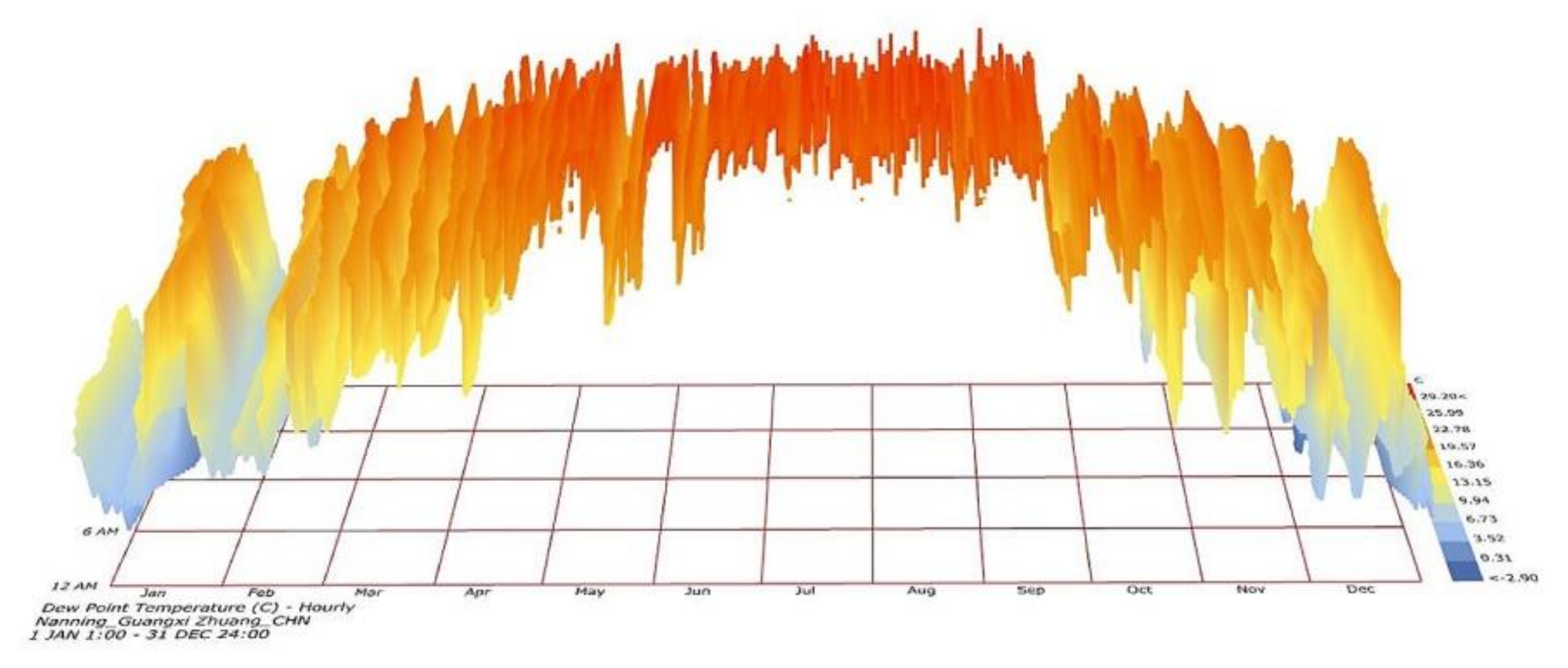
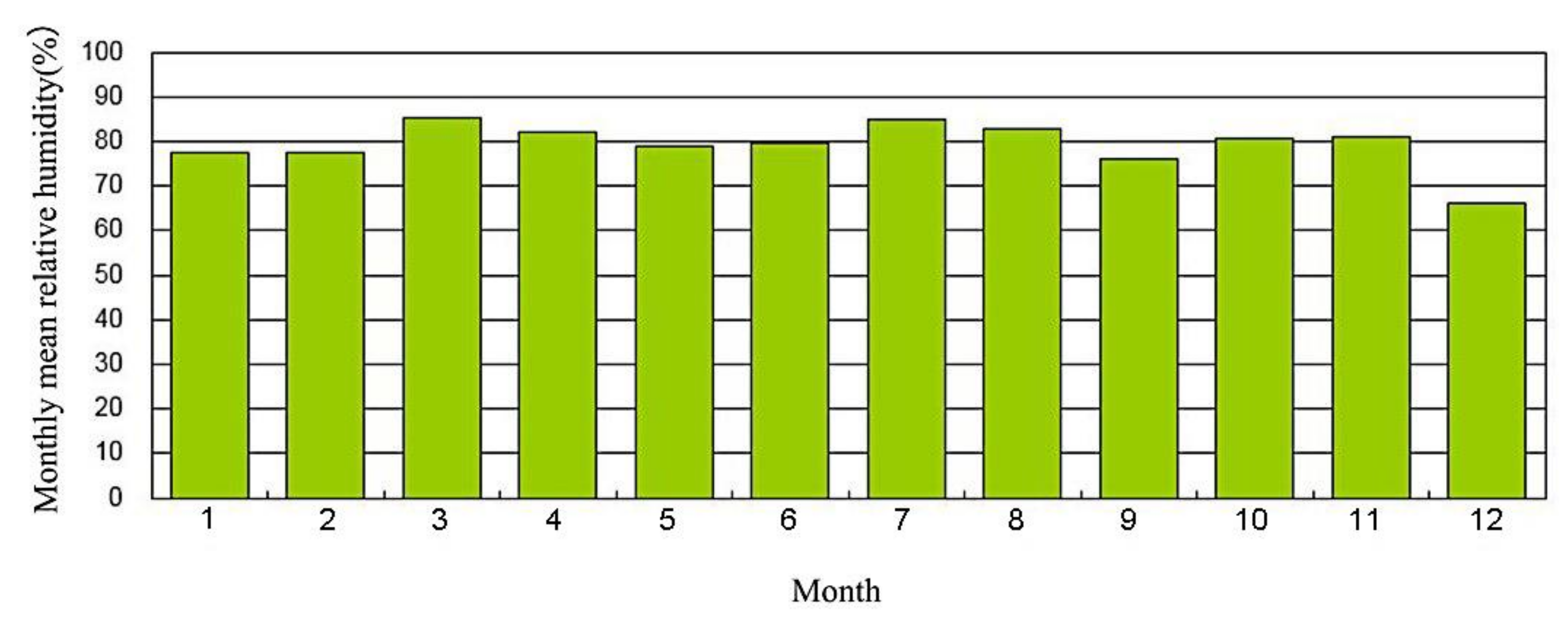
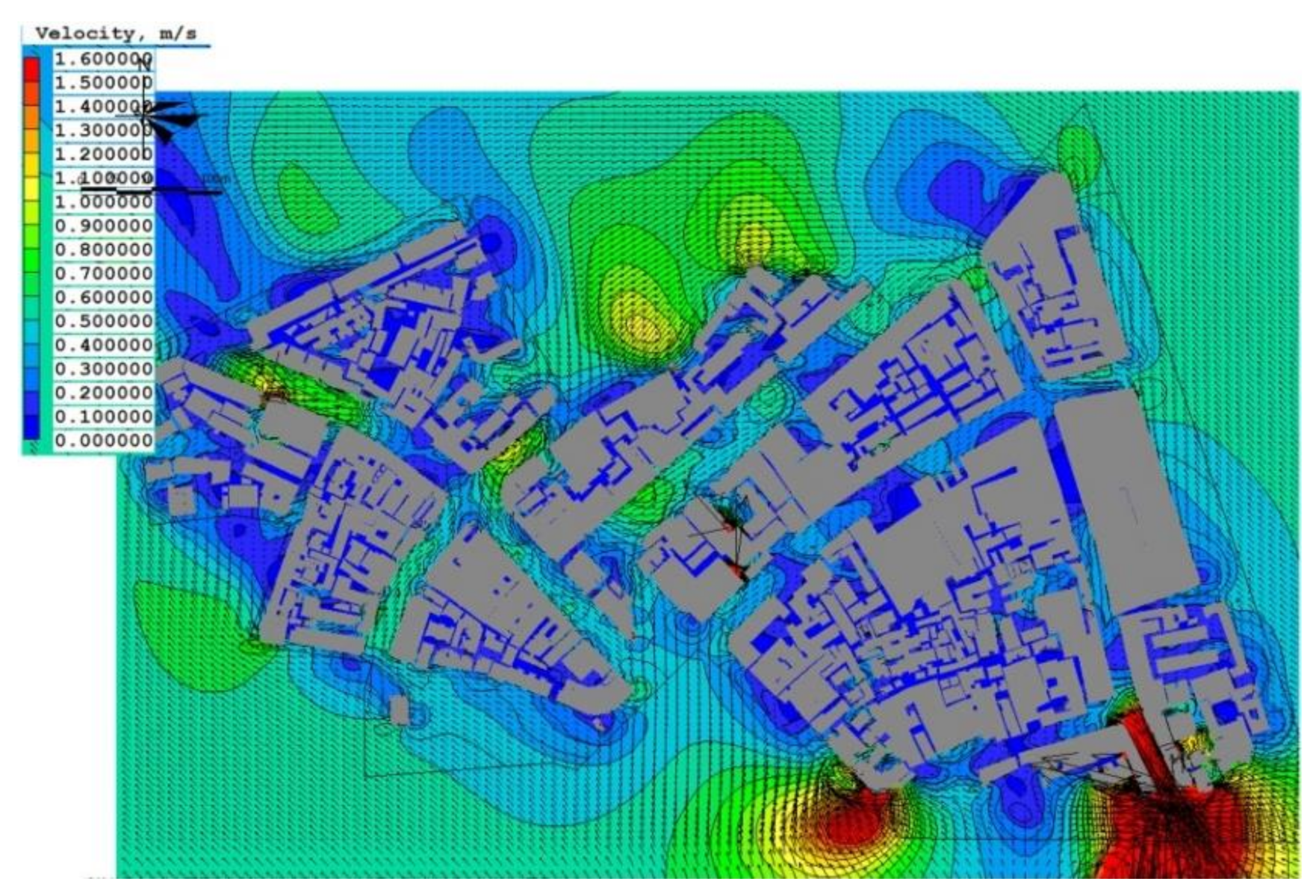
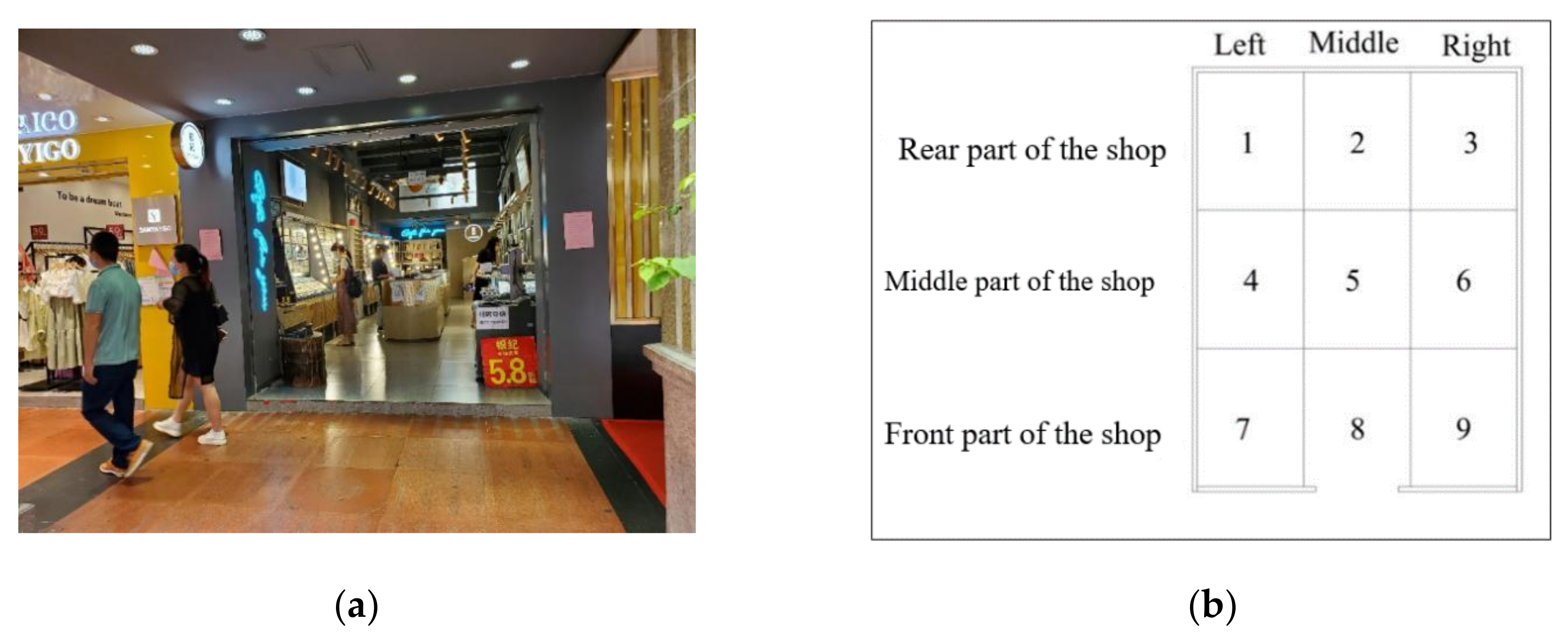
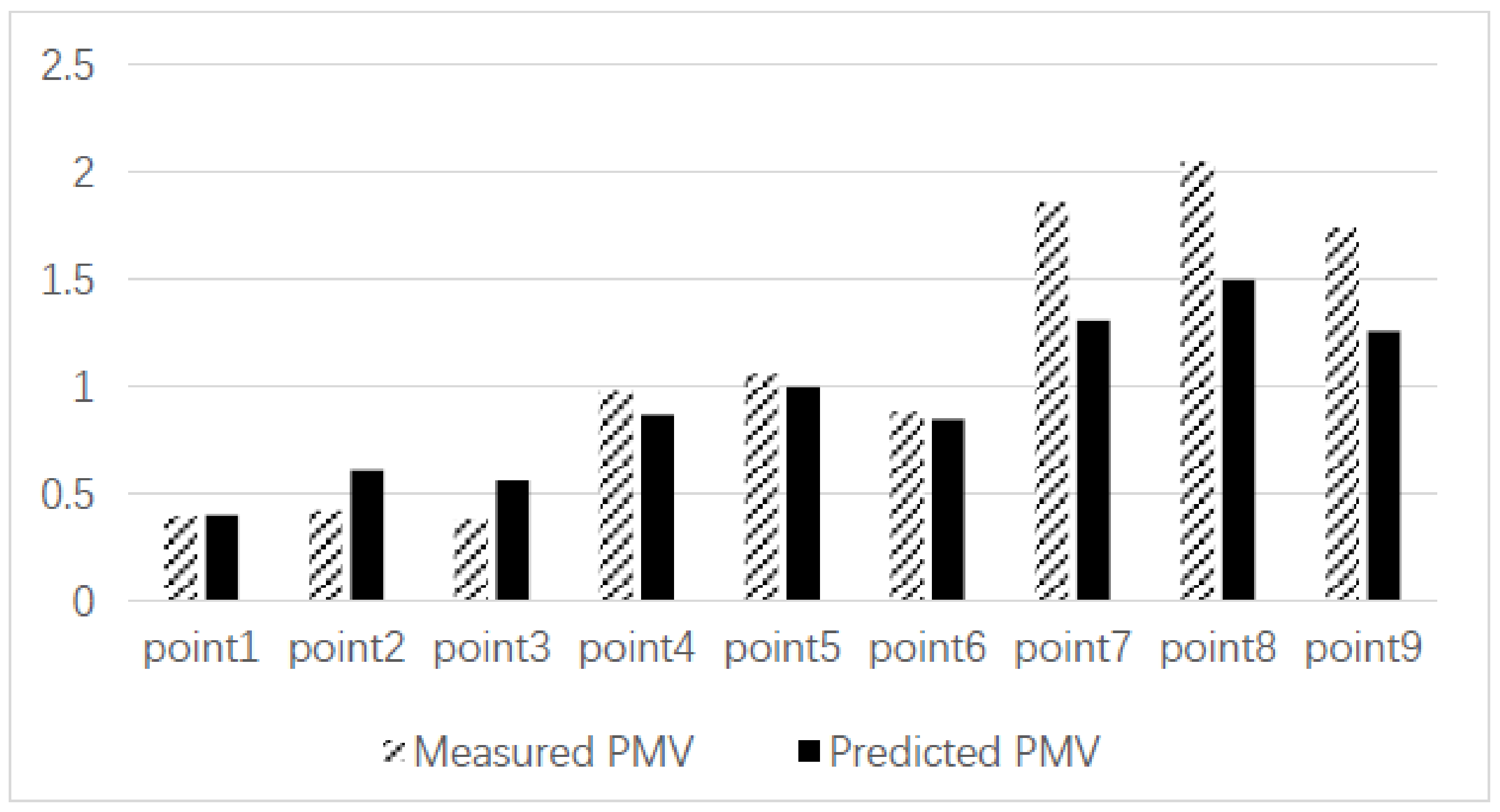
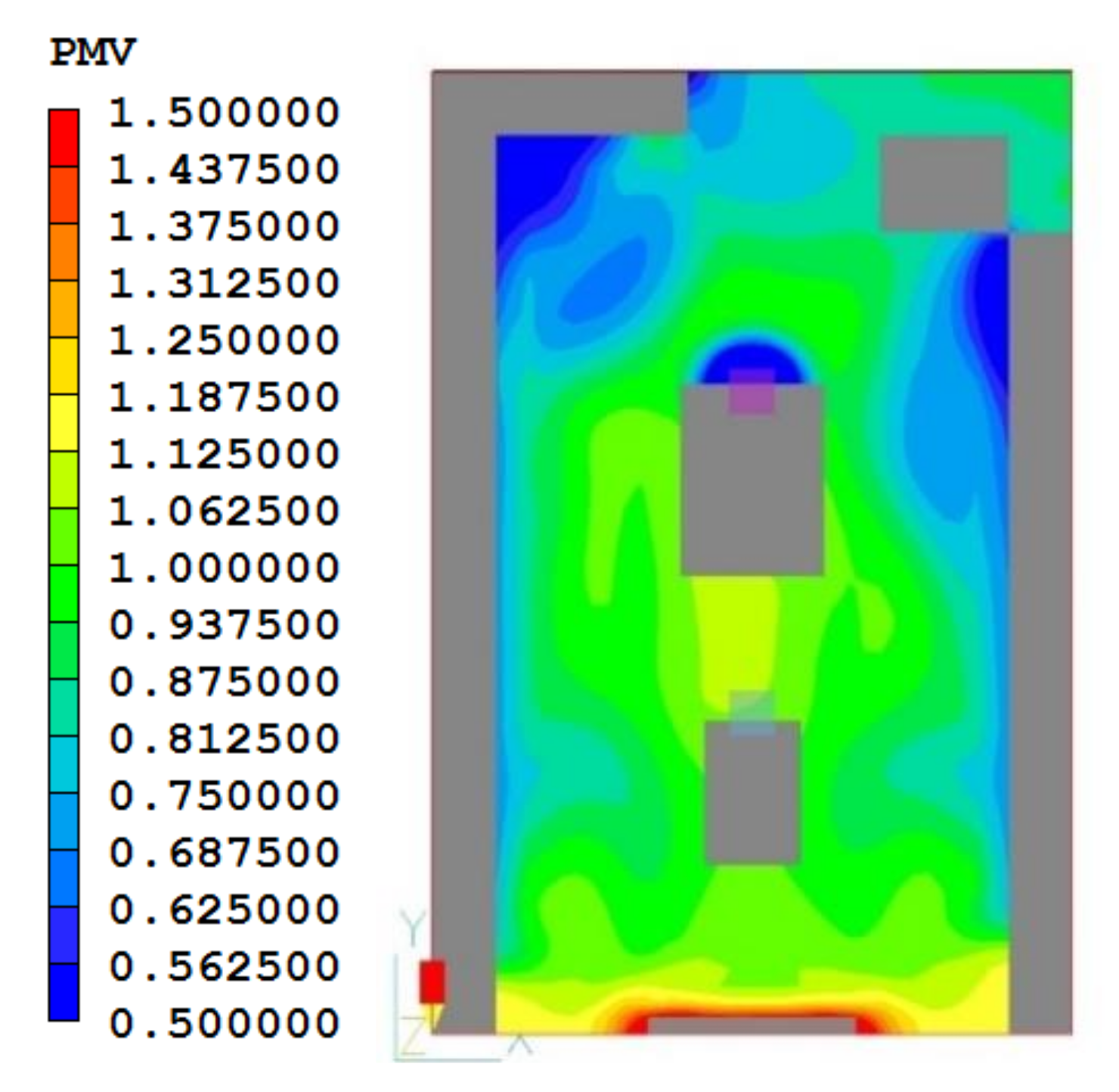
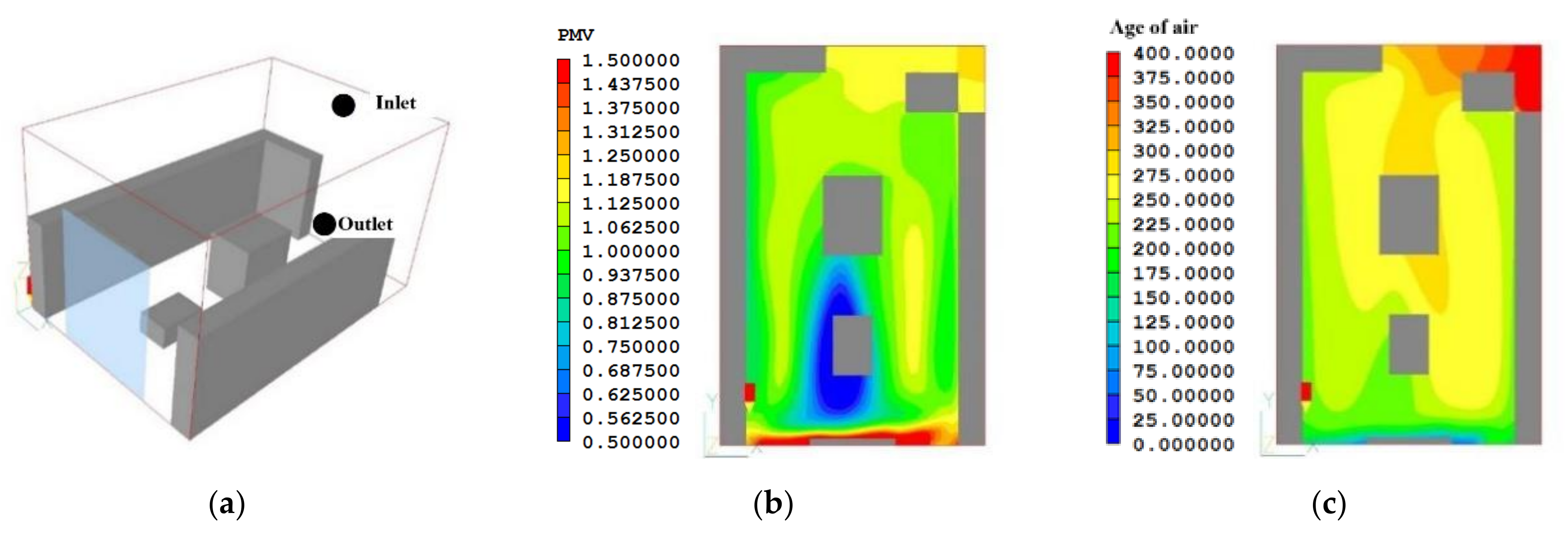

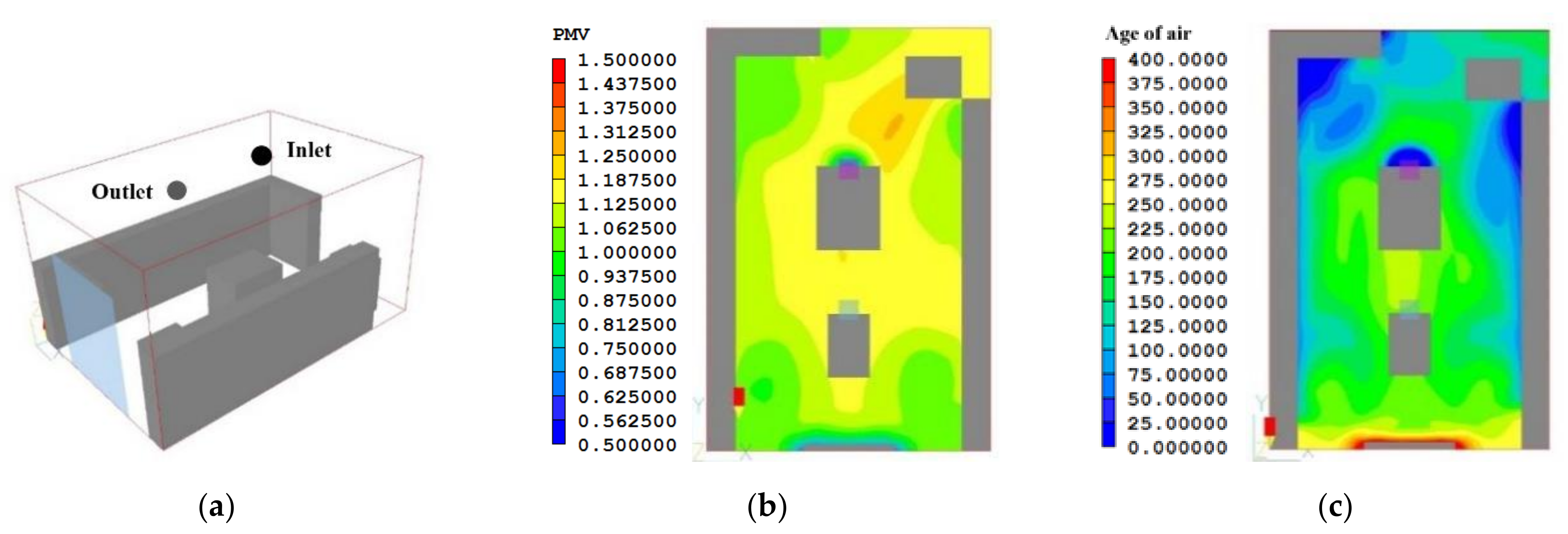
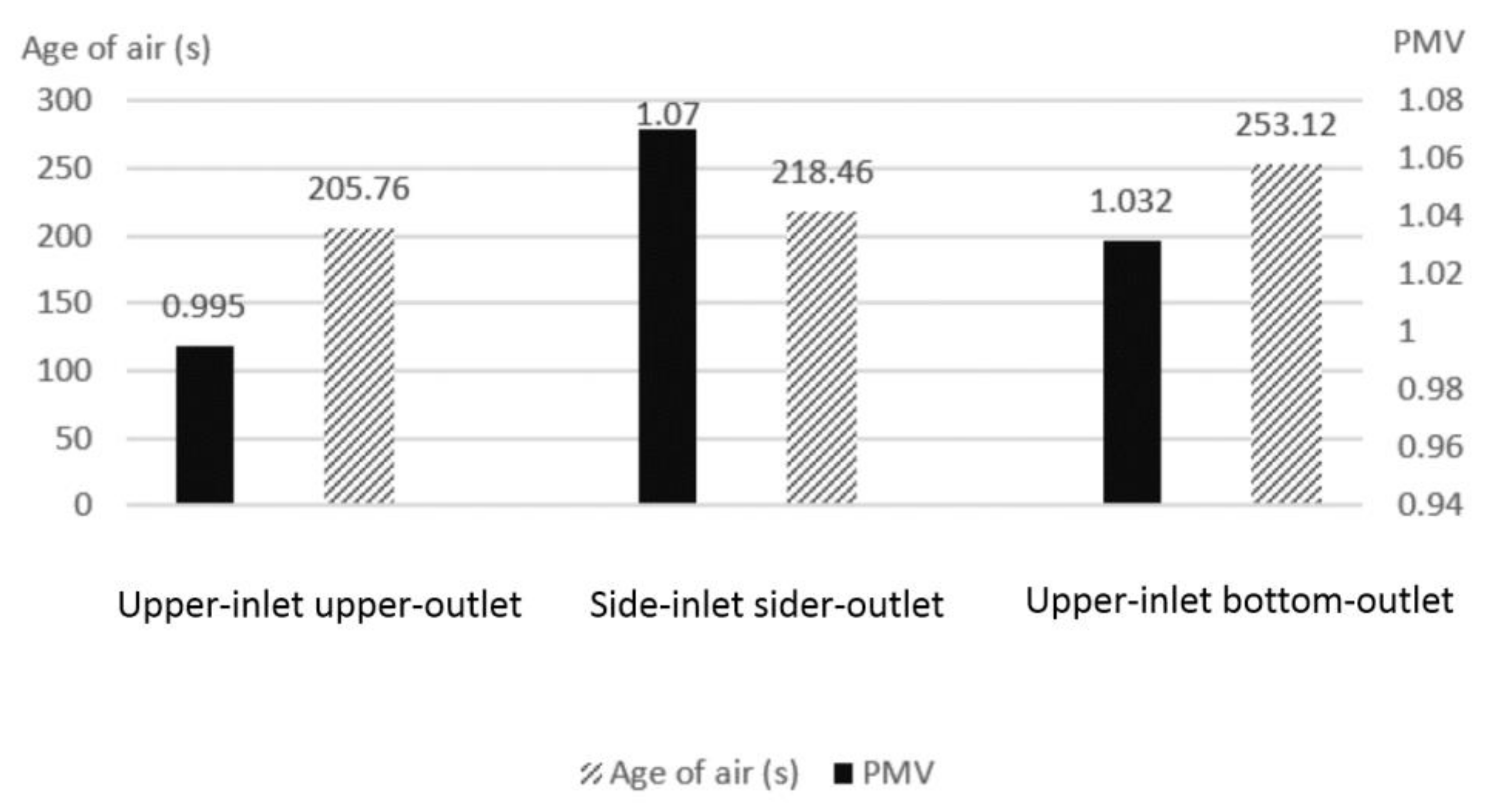
| Measurement Parameters | Measurement Range | Resolution |
|---|---|---|
| Temperature (°C) | −20–60 | 0.1 |
| Relative humidity (%) | 10–95 | 0.1 |
| Wind speed (m/s) | 0.1–30.0 | 0.01 |
| Measured Point | Air Temperature (°C) | Relative Humidity (%) | Wind Speed (m/s) |
|---|---|---|---|
| 1 | 27.54 | 70.25 | 0.059 |
| 2 | 27.74 | 71.27 | 0.098 |
| 3 | 27.00 | 72.03 | 0.164 |
| 4 | 29.05 | 62.82 | 0.063 |
| 5 | 29.21 | 63.44 | 0.041 |
| 6 | 28.79 | 64.08 | 0.055 |
| 7 | 31.20 | 72.29 | 0.111 |
| 8 | 31.62 | 72.60 | 0.139 |
| 9 | 30.92 | 72.04 | 0.111 |
| Parameter | Minimum | Maximum | Mean | S.D. |
|---|---|---|---|---|
| Air Temperature (°C) | 27.54 | 31.62 | 29.23 | 2.75 |
| Relative Humidity (%) | 62.82 | 72.60 | 68.98 | 6.89 |
| Air velocity (m/s) | 0.041 | 0.139 | 0.093 | 0.068 |
Publisher’s Note: MDPI stays neutral with regard to jurisdictional claims in published maps and institutional affiliations. |
© 2021 by the authors. Licensee MDPI, Basel, Switzerland. This article is an open access article distributed under the terms and conditions of the Creative Commons Attribution (CC BY) license (https://creativecommons.org/licenses/by/4.0/).
Share and Cite
Huang, X.; Qu, C. Research on Indoor Thermal Comfort and Age of Air in Qilou Street Shop under Mechanical Ventilation Scheme: A Case Study of Nanning Traditional Block in Southern China. Sustainability 2021, 13, 4037. https://doi.org/10.3390/su13074037
Huang X, Qu C. Research on Indoor Thermal Comfort and Age of Air in Qilou Street Shop under Mechanical Ventilation Scheme: A Case Study of Nanning Traditional Block in Southern China. Sustainability. 2021; 13(7):4037. https://doi.org/10.3390/su13074037
Chicago/Turabian StyleHuang, Xianfeng, and Chen Qu. 2021. "Research on Indoor Thermal Comfort and Age of Air in Qilou Street Shop under Mechanical Ventilation Scheme: A Case Study of Nanning Traditional Block in Southern China" Sustainability 13, no. 7: 4037. https://doi.org/10.3390/su13074037
APA StyleHuang, X., & Qu, C. (2021). Research on Indoor Thermal Comfort and Age of Air in Qilou Street Shop under Mechanical Ventilation Scheme: A Case Study of Nanning Traditional Block in Southern China. Sustainability, 13(7), 4037. https://doi.org/10.3390/su13074037






